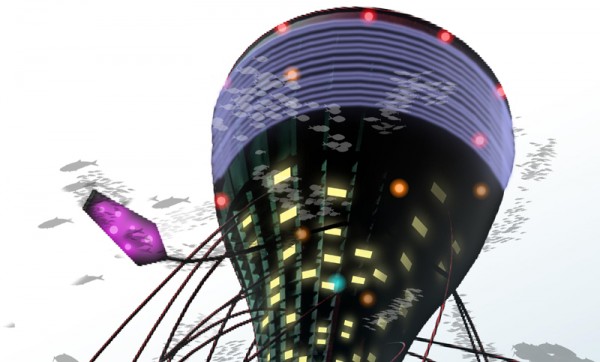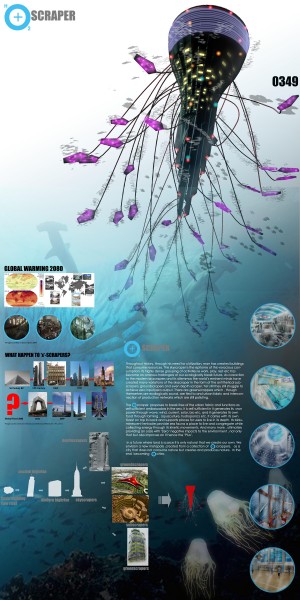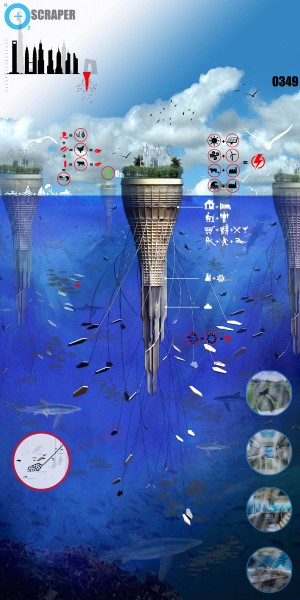Special Mention
2010 Skyscraper Competition
Sarly Adre Bin Sarkum
Malaysia
Throughout history, through his need for civilization, man has created buildings that consume resources. The skyscraper is the epitome of this voracious consumption, its highly dense grouping of activities ie work, play, rest etc has become an ominous harbingers of our ecologically bleak future. As a reaction to the modern skyscrapers and its dilemmas the world’s eminent minds have created many variations of the skyscraper in the form of the antithetical subscrapers, groundscrapers and even depth scraper. Yet still they still struggle to achieve zero input/zero output in terms of resource production. There are greenscrappers which , though themselves are ecologically sound, are tied to and urban fabric and interconnection of production networks which are still contributing negatively towards the environment.
The hO2+ scraper proposes to break free of the urban fabric and functions as self-sufficient ambassadors in the sea. The hO2+ scraper is an autonomous floating unit of livable, functional and self sustaining space which will function, in a collective manner, as a floating city. It is self sufficient as it generates its own power through wave, wind, current, solar, bio etc. and it generates its own food through farming, aquaculture, hydroponics etc. It carries with its own small forest on top its back and supports places for users to live and works in its depths. Its bioluminescent tentacles provide sea fauna a place to live and congregate while collecting energy through its kinetic movements. Such sustainability strategies aim to ultimately create and provide an oasis with ‘Zero’ negative impacts to the environment, not only that but also improves on it hence the ’Plus’. Aptly as poetic antithesis to a skyscraper which goes up into the heavens the hO2+ scraper goes down to the depths of the sea.
The main components of the programme for the hO2+ scraper consist of resource generation (i.e. power, food, air etc), living, work, play, waste treatment and maintenance. The programme is spread evenly in accordance to the proximity of any specific required external resource i.e. the wind generators are placed of the roof garden island, the livestock farming component is also placed there, the living areas are placed just below sea level where the natural light is the best etc.
The building itself is kept upright using a system of ballast and balancing tanks. The tentacles also serve as balancing elements as they, in generating their power, are constantly moving with the rhythm of the tide. The buoyancy and ballast controls are placed at the lowest portions to create the proper counterforce for keeping the building upright.
In the finality, we envision a future where land as a resource will be scarce; it is only natural progression that we create our own. Approximately 71% of the Earth’s surface is ocean, even more if climate change has its way, hence it is only natural progression that we will populate the seas someday. We picture a new metapolis, created from a collection of hO2+ scrapers, as a city that does not consume nature but creates and produces nature. In the end becoming hO2+ Cities.


















[…] to the sinking shoreline why not suit them for a life at sea? That’s the approach behind the Water-Scraper, a futuristic self-sufficient floating city. A special mention in this year’s eVolo […]
[…] to the sinking shoreline why not suit them for a life at sea? That’s the approach behind the Water-Scraper, a futuristic self-sufficient floating city. A special mention in this year’s eVolo Skyscraper […]
[…] the approach behind the Water-Scraper, a futuristic self-sufficient floating city. A special mention in this year’s eVolo Skyscraper […]
[…] ways—though if it just tastes like algae I might stick with city-living for a while longer. [Water-scraper via […]
[…] ways—though if it just tastes like algae I might stick with city-living for a while longer. [Water-scraper via […]
Now, if they were really genius, they’d use the Great Pacific Garbage Patch for their materials!
http://en.wikipedia.org/wiki/Great_Pacific_Garbage_Patch
http://www.youtube.com/watch?v=en4XzfR0FE8
[…] ways—though if it just tastes like algae I might stick with city-living for a while longer. [Water-scraper via […]
[…] ways—though if it just tastes like algae I might stick with city-living for a while longer. [Water-scraper via […]
[…] as a self-sufficent floating city, Sarly Adre Bin Sarkum’s Water-Scraper utilizes a variety of green technologies. It generates its own electricity using wave, wind, and […]
I like the idea of having a city or partial intercity building out in the sea… However, in this design, is most uneducated and unrealistic idea ever.
[…] eVolo, via Gizmodo […]
[…] – though if it just tastes like algae I might stick with city living for a while longer. [Water-scraper via […]
[…] Water-Scraper: El rascacielos submarino http://www.evolo.us/competition/water-scraper-underwater-architecture/ por CIB3R hace 3 segundos […]
Please, enlighten us.
The garbage patch doesn’t really exist. Trash gets broken down to tiny, tiny pieces way before it could form a garbage island. I mean, have you ever seen a picture of it? Don’t you think someone would have photographed a Texas-sized island? I think it would be visible on Google Earth, but it’s nowhere to be seen.
Hawaii is where the garbage patch should be. Have you ever heard anyone complain that their Hawaii holiday was ruined because the waters were filthy? Neither have I.
A short video detailing this: http://blip.tv/play/AYHBiAsC
@nappi
So, you were motivated enough to link to a ridiculous video “disproving” the garbage patch, but too lazy to read anything beyond the headline of any article discussing the garbage patch?
1) The Great Pacific Garbage Patch does in fact exist; it’s actually one of several.
2) No one credible has ever claimed that it was a solid island. To quote abovelinked wikipedia article you didn’t read: “the patch is defined as an area in which the mass of plastic debris in the upper water column is significantly higher than average.” It’s an area of water filled with a soupy mixture of plastic.
3) The gyre doesn’t accumulate debris near Hawaii; the patch is actually in between Hawaii and CA.
4) Google is your friend.
How, in Poseidon’s name, do you adequately deal with pressure variances? A resident couldn’t possibly travel from bottom to top without some mandatory stop at a pressure relieving station. So the large majority of citizens would have to live in a fixed quadrant of the city, and if a crisis occurred that required total evacuation, there would be pure bedlam in try to move people out as fast as The Bends would let them.
Wonderful idea, but the difficulties are perhaps greater than our abilities for the next 100-200 years.
[…] ways—though if it just tastes like algae I might stick with city-living for a while longer. [Water-scraper via […]
[…] be. A recent skyscraper concept competition yielded some really interesting designs, among them this utterly amazing concept, which they inexplicably call a “water-scraper” instead of the decidedly more […]
Maybe if the station was filled with water….. The air pressure ( the only pressure the humans would be exposed too ) would be kept consent throughout the whole structure.
[…] ways—though if it just tastes like algae I might stick with city-living for a while longer. [Water-scraper via […]
Is it just assumed that the forest on top will provide fruits and vegetables or was it forgotten, with more emphasis placed on the fish, bread and animal products. Because honestly, it’ll be incredibly difficult to fit all that on top of the building, especially if you’re trying to provide for everyone who’ll live there. I do think that the methods of generating electricity are good ideas, but it won’t really be self-sufficient food-wise. And where does the water come from? Does it have a desalination mechanism at the base (with the cloud symbol)? Or tanks at the top? Both options also won’t provide for an entire building. What is the building made out of? How will it be zero-impact if the materials required are dug out of the earth through energy intensive means?
On the other hand, the energy harvesting is brilliant and the tentacles are a fascinating idea. It would probably end up being one company per building, however, so families would either have a single working adult or two adults working in the same company, if one ignores the restaurants and such. It also isn’t too deep; it’s just taller than the Leaning Tower of Pisa (56.7m) so if there is an emergency diving won’t be ruled out as an exit strategy (although it’s still a little iffy). There are some obvious problems with the idea but it is good to see people attempting to address the problems caused by climate change. ***
[…] Wasserkratzer, oder wie auch immer man dieses Konzept am Besten auf Deutsch übersetzt, ist ein negatives […]
[…] Via: Evolo/Inhabitat […]
[…] Water-Scraper: Hochhäuser unter Wasser via evolo.us […]
[…] Evolo/Inhabitat March 10th, 2010 in Design, Other | tags: earth, floating city, scraper-city, […]
[…] [Water-scraper via Inhabitat] […]
[…] [Water-scraper via Inhabitat] […]
humans continue destroying the planet